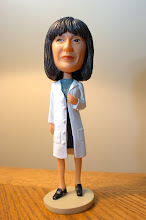In the spirit of the season and while we are discussing sugar and carbohydrates, I thought I'd share a couple of recipes for holiday treats.
Sugarplums:
Not many people have had an actual sugarplum, but they don't only exist in book & song. A sugarplum was originally a candied plum; a way to preserve the taste of summer all year long. Somewhere along the way it became a mixture of dried fruits and nuts. And as far as Christmas candy goes, this is pretty healthy!
1 cup pitted dates (or figs)
1 cup toasted almonds
1 cup dried apricots
1/3 cup pistachios
1/3 cup candied ginger
2 tbsp grated orange zest (or lemon)
2-3 tbsp orange juice (or lemon)
Demerara sugar (or other large granular sugar)
Add everything except orange juice & sugar to a food processor & process until minced. Add juice until mixture sticks together. Form into 1" balls and roll in the sugar. Place in small, fluted cups or arrange on a platter.
This is just a basic recipe - feel free to get creative. You can add prunes, cherries, raisins, coconut, etc. Add what you like and what makes you happy. Next time you hear the Nutcracker Suite you really will have visions of sugarplums in your head!
Lollipops:
Lollipops are so simple, but they are interesting chemically. There is a finite amount of sugar you can dissolve in water, called a saturated solution (just over 200g sugar per 100g of water at 20°C). But as you increase the temperature of the water, you can increase the amount of sugar in solution forming a super-saturated solution. Unfortunately super-saturated solutions aren't very stable; the sugar wants to recrystallize. Since lollipops are amorphous, not crystalline, this is a problem. Luckily, it is one that isn't too hard to solve. For starters, wet down the sides of your pot to keep crystals from developing. These can become "seed crystals"; if they fall in the super-saturated solution they can cause the crystals to redevelop. We also add corn syrup (full of glucose & fructose molecules) to run interference with the sucrose molecules and break up their party. And lastly, don't stir the solution once it hits a boil; agitation is also something that causes the sucrose to recrystallize. We want clear, smooth lollipops not gritty, opaque ones.
1 cup sugar
1/3 cup light corn syrup
1/2 cup water
1/2 to 1 tsp Flavored Oil (cherry, cinnamon, peppermint, anise) of your choosing
Food coloring as desired
Candy thermometer
Paper or wooden lollipop sticks
Silpat or oiled baking sheet or oiled marble slab
Stir sugar, corn syrup, and water in a heavy saucepan. Bring to a boil stirring often and brushing down the sides of the pan with a wet pastry brush. Once boiling, cover and let boil 2-3 minutes. Uncover and put in candy thermometer, bring to 290°F. Remove from heat, add color & flavored oil; cool to 280°F. Spoon onto silpat or oiled surface (or into molds). Add sticks while still hot & pliable; spoon a small amount of candy over the stick to help hold it in place. Let cool completely.
I hope you are inspired to try one (or both!) of these recipes and that you've learned something new. I've had fun with all of this sweet talk but I promise to move on from sugar in the next post, before we all get cavities from the sugar overload!
Tuesday, December 11, 2007
Subscribe to:
Post Comments (Atom)






No comments:
Post a Comment